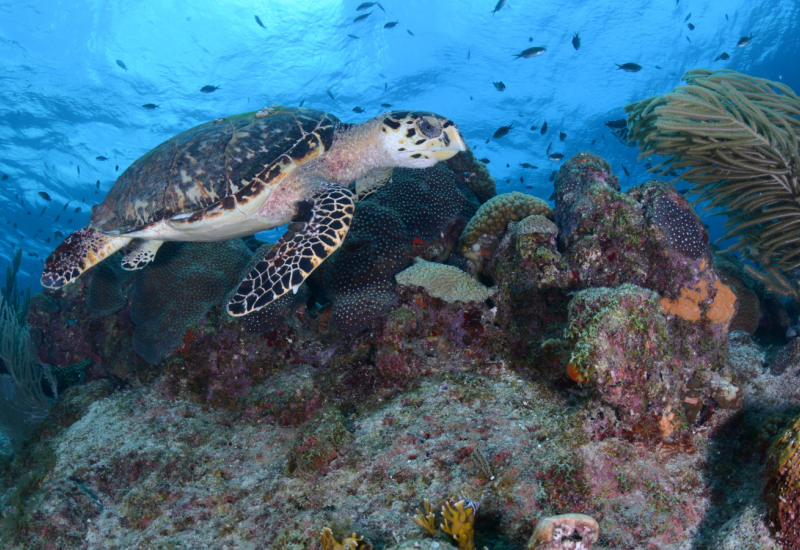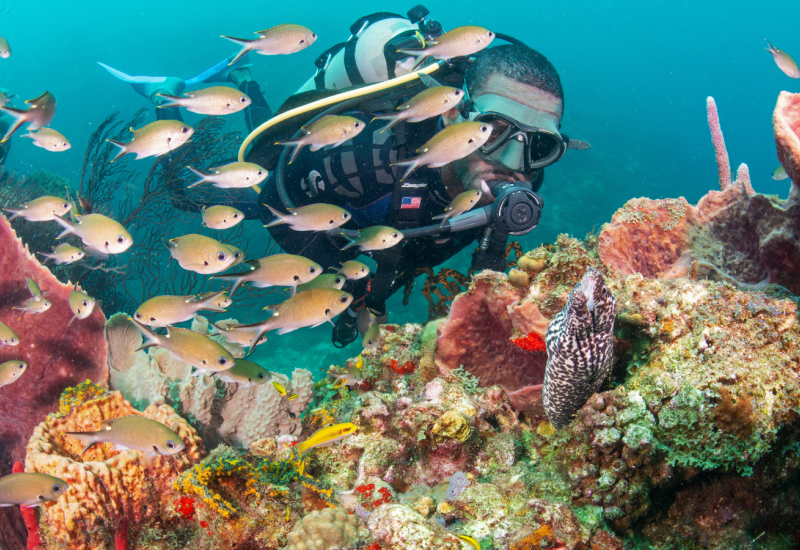Clean Water, Happy Reefs
Most divers would probably rather not dive in wastewater — even if it’s been treated. But as new treatment plants are built in coastal communities to accommodate growing populations and more tourists, more wastewater will likely end up being sent into the ocean. When it comes to coral reefs, the old adage “dilution is the solution” is just not true: Even highly diluted wastewater can harm reefs.
Coral thrives in clean, clear water, where the microscopic algae that live inside the corals can capture energy from the sun and feed the corals with the sugars produced by this photosynthesis. In areas where wastewater is discharged or leaches into the ocean near reefs, leftover nutrients — primarily nitrogen — can encourage seaweed to overgrow reefs, essentially suffocating them. A new long-term study done on reefs in Florida shows that excess nutrients can also cause bleaching and diseases. Yet reefs can usually recover after the pollutants are removed, says Rebecca Vega-Thurber, one of the study’s authors.
In West Maui, an innovative program that will help solve nutrient pollution is gaining momentum. Traditionally the county of Maui has sent wastewater from its treatment plants into wells. From there, however, it can make its way through groundwater to the reefs just off the coast.
To tackle that problem — as well as to help preserve Maui’s potable-water supply — the county of Maui is expanding its distribution system for R-1 water: recycled water treated to the highest standard possible. As hotels hook up to the R-1 system, they will not only be using less potable water for needs such as landscape irrigation (thus conserving potable water), but also — and most important for reefs — the amount of treated wastewater that ends up making its way to reefs is less. The Coral Reef Alliance (CORAL) is working with hotels and resorts to help them navigate the regulatory requirements for retrofitting their equipment and adjusting their landscaping practices to use R-1 water. This fall, CORAL published “Recycled Water for Reefs,” a how-to booklet for resorts and hotels (available at coral.org/hawaiiwater).
Of course wastewater is not the only source of pollution threatening reefs — storm-water runoff often carries heavy metals, grease, fertilizers, pesticides and other pollutants into the ocean.
CORAL is partnering with the West Maui Ridge to Reef Initiative to promote the use of rain gardens and to help install them. Rain gardens and other “green infrastructure” like bioswales or green roofs capture the runoff before it races downhill, downstream and into the ocean. Microorganisms in the soil and plants in the rain gardens also help filter the pollutants. The goal behind the initiative is to restore and enhance the health and resilience of West Maui’s reefs and nearshore waters — from the highest summit to the outer reef, a true watershed approach.
Lisa Paulson, executive director of the Maui Hotel and Lodging Association, says making sure visitors and residents have cleaner water in which to swim, snorkel and dive is a priority for her organization. She loves the way businesses, nonprofits and citizen volunteers are working together toward the goal of a healthier watershed — with reefs at the downstream end. In 2012, Maui hosted 2.3 million visitors, to the tune of $3.6 billion added to the local economy. Says Paulson: “Our reefs are integral to everybody’s visit. I would say that 90 percent of people who come to this island are in the ocean. We all realize that if we don’t maintain our reefs and ocean, we’re going to lose the main reason people come visit the island.”
HOW YOU CAN HELP
1. Conserve water so less runoff and wastewater end up in the ocean.
2. Consider planting a rain garden on your property to absorb polluted runoff from hard surfaces.
3. Avoid using pesticides or chemical fertilizers in your garden — they can end up in our waterways or the ocean.
4. Leave only bubbles when you dive or snorkel. If you visit a reef, look, but don’t step on it or touch it.
5. Collect any **trash you see in the water when diving or snorkeling, and be sure not to leave any trash. Participate in beachand creek-cleanup events wherever you live to help remove trash that can make its way to the ocean.
Learn more about coral reefs — and join the Coral Reef Alliance — at coral.org.

David Fleetham/Visuals UnlimitedClean water is key to a healthy, vibrant coral reef ecosystem, which includes apex predators like this whitetip reef shark.
Wastewater is water that goes from your sink, toilet or shower to a treatment plant. Once it is treated — suspended solids and certain other targeted compounds removed — it is usually sent, diluted, into a large body of water, usually the ocean, unless it can be reused first, such as in “treatment” wetlands. Even treated and diluted, such water still is harmful to reefs because of its remnant nutrients. Hawaii requires that water designated “R-1” must be treated by oxidation and filtration, and disinfected with UV light, to significantly reduce bacteria and viruses. It can be used for toilet flushing, commercial laundry, cleaning, HVAC cooling systems, water features and fire protection, but in Maui, it is currently being used only for hotel grounds and golf-course irrigation.

Courtesy West Maui Ridge to Reef InitiativeOne of West Maui’s successful rain gardens.
Most divers would probably rather not dive in wastewater — even if it’s been treated. But as new treatment plants are built in coastal communities to accommodate growing populations and more tourists, more wastewater will likely end up being sent into the ocean. When it comes to coral reefs, the old adage “dilution is the solution” is just not true: Even highly diluted wastewater can harm reefs.
Coral thrives in clean, clear water, where the microscopic algae that live inside the corals can capture energy from the sun and feed the corals with the sugars produced by this photosynthesis. In areas where wastewater is discharged or leaches into the ocean near reefs, leftover nutrients — primarily nitrogen — can encourage seaweed to overgrow reefs, essentially suffocating them. A new long-term study done on reefs in Florida shows that excess nutrients can also cause bleaching and diseases. Yet reefs can usually recover after the pollutants are removed, says Rebecca Vega-Thurber, one of the study’s authors.
In West Maui, an innovative program that will help solve nutrient pollution is gaining momentum. Traditionally the county of Maui has sent wastewater from its treatment plants into wells. From there, however, it can make its way through groundwater to the reefs just off the coast.

Shutterstock.
To tackle that problem — as well as to help preserve Maui’s potable-water supply — the county of Maui is expanding its distribution system for R-1 water: recycled water treated to the highest standard possible. As hotels hook up to the R-1 system, they will not only be using less potable water for needs such as landscape irrigation (thus conserving potable water), but also — and most important for reefs — the amount of treated wastewater that ends up making its way to reefs is less. The Coral Reef Alliance (CORAL) is working with hotels and resorts to help them navigate the regulatory requirements for retrofitting their equipment and adjusting their landscaping practices to use R-1 water. This fall, CORAL published “Recycled Water for Reefs,” a how-to booklet for resorts and hotels (available at coral.org/hawaiiwater).
Of course wastewater is not the only source of pollution threatening reefs — storm-water runoff often carries heavy metals, grease, fertilizers, pesticides and other pollutants into the ocean.
CORAL is partnering with the West Maui Ridge to Reef Initiative to promote the use of rain gardens and to help install them. Rain gardens and other “green infrastructure” like bioswales or green roofs capture the runoff before it races downhill, downstream and into the ocean. Microorganisms in the soil and plants in the rain gardens also help filter the pollutants. The goal behind the initiative is to restore and enhance the health and resilience of West Maui’s reefs and nearshore waters — from the highest summit to the outer reef, a true watershed approach.
Lisa Paulson, executive director of the Maui Hotel and Lodging Association, says making sure visitors and residents have cleaner water in which to swim, snorkel and dive is a priority for her organization. She loves the way businesses, nonprofits and citizen volunteers are working together toward the goal of a healthier watershed — with reefs at the downstream end. In 2012, Maui hosted 2.3 million visitors, to the tune of $3.6 billion added to the local economy. Says Paulson: “Our reefs are integral to everybody’s visit. I would say that 90 percent of people who come to this island are in the ocean. We all realize that if we don’t maintain our reefs and ocean, we’re going to lose the main reason people come visit the island.”

Michael Patrick O'NeillCollect any trash you see in the water when diving or snorkeling, and be sure not to leave any trash. Participate in beach- and creek-cleanup events wherever you live to help remove trash that can make its way to the ocean.
HOW YOU CAN HELP
1. Conserve water so less runoff and wastewater end up in the ocean.
2. Consider planting a rain garden on your property to absorb polluted runoff from hard surfaces.
3. Avoid using pesticides or chemical fertilizers in your garden — they can end up in our waterways or the ocean.
4. Leave only bubbles when you dive or snorkel. If you visit a reef, look, but don’t step on it or touch it.
5. Collect any **trash you see in the water when diving or snorkeling, and be sure not to leave any trash. Participate in beachand creek-cleanup events wherever you live to help remove trash that can make its way to the ocean.
Learn more about coral reefs — and join the Coral Reef Alliance — at coral.org.










